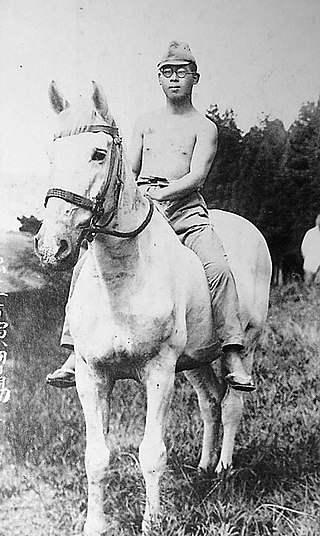Language-based profanity
In Japanese culture, social hierarchy plays a significant role in the way someone speaks to the various people they interact with on a day-to-day basis. [5] Choice on level of speech, politeness, body language and appropriate content is assessed on a situational basis, [6] and intentional misuse of these social cues can be offensive to the listener in conversation. [2]
Pronouns and suffixes
Pronouns are rarely used in Japanese compared to English. Rather, a Japanese speaker would refer to another individual, whether it be in the second person or third person, by their family name. However, when referring to an individual, the use of suffixes on pronouns can be used to indicate levels of politeness. [6]
For example, in English one could say "Excuse me, Ms. Ishiyama, but I cannot hear you. Could you please speak louder?", the following would be an incorrect translation:
- (1) 石山先生、すみませんが私はあなたを聞こえません。あなたはもっと大きい声で話してくれませんか? (Ishiyama-sensei, sumimasen ga watashi wa anata wo kikoemasen. Anata wa motto ōkii koe de hanashitekuremasen ka?)
Japanese exhibits pronoun avoidance, meaning that using pronouns is often too direct in Japanese, and considered offensive or strange. [6] One would not use pronouns for oneself, 私 (watashi, 'I'), or for another, あなた (anata, 'you'), but instead would omit pronouns for oneself, and call the other person by name:
- (2) 石山先生、すみませんが、聞こえません。もっと大きい声で話してくれませんか? (Ishiyama-sensei, sumimasen ga, kikoemasen. Motto ōkii koe de hanashitekuremasen ka?)
The use of 'Ishiyama' (石山) instead of her first name and the use of 'teacher' (先生, sensei) as a suffix indicates recognition of Ms. Ishiyama's superiority in the social hierarchy as one's teacher.
In contrast, if one were to say:
- (3) ごめん、聞こえない。もっと大きい声で言って。 (Gomen, kikoenai. Motto ōkii koe de itte.)
to one's teacher, it would be considered incredibly impolite. Ms. Ishiyama's status is not mentioned, indicating that the speaker considers themselves to be of equal or high social standing.
Honorific language
Profanity can be accentuated also through use (or lack) of honorific language (敬語 けいご keigo). Following on from pronouns and suffixes in the example above, the speaker has contracted the words for 'excuse me/sorry' (すみません sumimasen to ごめん gomen), 'I cannot hear you' (聞こえません kikoemasen to 聞こえない kikoenai) and 'can you speak' (話してくれませんか hanashitekuremasenka to 言って itte).
Politeness can be conveyed to the listener by conjugating plain forms (verb stems) of Japanese verbs into what is called the polite form. [7]
Consider the original example. The plain form verb for 'listen' is 聞く kiku. The potential form [8] of this is 聞こえる kikoeru, and the corresponding negative form is 聞こえない kikoenai. [9] The polite conjugation of the negative potential plain form is then 聞こえません kikoemasen, as seen in the example (1). In example (3) the speaker has chosen to use the plain form 聞こえない kikoenai, and this indicates a disregard for the social hierarchical status of Ms Ishiyama over the speaker.

Bowing
Bowing was introduced into Japanese culture c. 500–800 CE, possibly alongside the introduction of Chinese Buddhism into the country. Bowing when greeting another person has become a large part of Japanese culture and there are specific customs that are followed to show humility and respect in situations including business meetings, formal occasions, and day-to-day interactions. [10] When performing a standing bow (正立 seiritsu) to another Japanese speaker, the individual's back should remain straight, with their hands by their side, and eyes averted to the ground. From sitting, the individual should be seated on their knees (正座 seiza) with their hands forming a triangle on the floor in front of them, and head moving towards the hands. [10] The bow does not need to be held for extended time, however the action should not be rushed either. The speed in which the bow is performed, as a result, can infer levels of politeness or rudeness.
The depth of the bow performed by an individual changes the meaning of the bow. A bow of 15 degrees is considered a casual bow or greeting bow (会釈 eshaku). This sort of bow can be used with someone of equal social hierarchical status such as a colleague or friend's friend. A bow of 30 degrees is considered a polite bow (浅礼 senrei) and should be made from seiza , not from seiritsu. This sort of bow is used in semi-formal situations. A bow of 45 degrees is a respectful bow (敬礼 keirei) and can be done while seated or standing. The respectful bow is used when greeting a superior such as an employer, or in-laws. Finally, a deep bow of greater than 45 degrees is called a reverent bow (最敬礼 saikeirei) and this is reserved either for an audience with the emperor or to communicate a deep reverence or regret.
With regards to profanity, using an overly polite or reverent form of bowing can display sarcasm and disdain, and conversely, choosing an inappropriately familial bow can be offensive to the other party.






